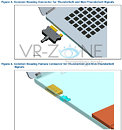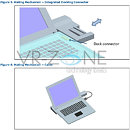- Joined
- Oct 9, 2007
- Messages
- 47,194 (7.56/day)
- Location
- Hyderabad, India
| System Name | RBMK-1000 |
|---|---|
| Processor | AMD Ryzen 7 5700G |
| Motherboard | ASUS ROG Strix B450-E Gaming |
| Cooling | DeepCool Gammax L240 V2 |
| Memory | 2x 8GB G.Skill Sniper X |
| Video Card(s) | Palit GeForce RTX 2080 SUPER GameRock |
| Storage | Western Digital Black NVMe 512GB |
| Display(s) | BenQ 1440p 60 Hz 27-inch |
| Case | Corsair Carbide 100R |
| Audio Device(s) | ASUS SupremeFX S1220A |
| Power Supply | Cooler Master MWE Gold 650W |
| Mouse | ASUS ROG Strix Impact |
| Keyboard | Gamdias Hermes E2 |
| Software | Windows 11 Pro |
The only way mainstream portable wintels are going the survive the onslaught of smaller, increasingly powerful and energy-efficient computing devices (such as ARM-driven tablets and smartphones), is by slimming down radically, and making themselves available to the mainstream. No, we're not talking about cheapo netbooks, but ultrabooks (ultra-slim notebooks), that provide mainstream notebook-like performance in a much more compact package. Intel will give this form-factor a big push next year with an Ivy Bridge architecture-based processor platform designed keeping it in mind, and technologies centric to it.
To begin with, slimmer form-factors could eat into wired connectivity, hence, Intel will push its Thunderbolt 10 Gb/s interconnect to the fore. But wired connectivity is the least of ultrabook's limitations. Battery life, data storage, and additional computing power will need to be accessible yet optional to it, and hence docking stations will be hot in the market, yet again. Intel will pitch for Thunderbolt to be a standard component of docking port clusters.


Typically, these are pairs of ports, consisting of one Thunderbolt, and a complex-port of non-Thunderbolt connections that will be drawn into either slots (slot-type docking) or ports (cabled docking). The Thunderbolt connector will be able to convey DisplayPort signals, as well as 10 Gb/s of raw bandwidth for any device that needs it. A single port can be daisy-chained across multiple devices to effectively make use of that bandwidth. The exact composition of the non-Thunderbolt could vary, but it could contain connections such as DC power (supplementary battery), USB, SATA, PCI Express (direct from the system's root-complex), and miscellaneous connectivity. Manufacturers of ultrabooks and docking stations will be expected to follow this specification.
View at TechPowerUp Main Site
To begin with, slimmer form-factors could eat into wired connectivity, hence, Intel will push its Thunderbolt 10 Gb/s interconnect to the fore. But wired connectivity is the least of ultrabook's limitations. Battery life, data storage, and additional computing power will need to be accessible yet optional to it, and hence docking stations will be hot in the market, yet again. Intel will pitch for Thunderbolt to be a standard component of docking port clusters.


Typically, these are pairs of ports, consisting of one Thunderbolt, and a complex-port of non-Thunderbolt connections that will be drawn into either slots (slot-type docking) or ports (cabled docking). The Thunderbolt connector will be able to convey DisplayPort signals, as well as 10 Gb/s of raw bandwidth for any device that needs it. A single port can be daisy-chained across multiple devices to effectively make use of that bandwidth. The exact composition of the non-Thunderbolt could vary, but it could contain connections such as DC power (supplementary battery), USB, SATA, PCI Express (direct from the system's root-complex), and miscellaneous connectivity. Manufacturers of ultrabooks and docking stations will be expected to follow this specification.
View at TechPowerUp Main Site
Last edited:

